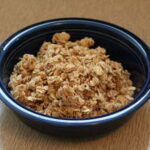Quick — over there in aisle 5: Energy bars. Granola Bars, Nutrition bars. They go by many names. They’re convenient: stick one in your pocket on the way to school, eat few with lunch or in place of lunch or bring a few to the gym for some quick fuel during a workout. Americans spend over a billion dollars each year on energy bars. The question is — just how healthy for you are they?
Nutritionists agree that not all energy bars are created equal. There are high-carbohydrate bars, protein bars, energy bars, breakfast bars, brain-boosting bars, meal-replacement bars, singles bars and diet bars. And with so much to choose from, you can easily go cross-eyed from all the product overkill and heavily hyped claims.
Dawn Jackson, RD, spokeswoman for the American Dietetic Association Foundation (www.adaf.org), notes that “…some of the bars have as much sugar and as much saturated fat as a candy bar…”
Some nutritionists have put energy bars to the test. According to a studypublished onwww.onhealth.webmd.com, nutritionistsat Ohio State University (www.osu.edu) looked to demonstrate that endurance athletes may not get the sustained energy boost that they’re expecting from certain energy bars. The research compared the effects on blood glucose levels of two popular energy bars — the Ironman PR Bar and the PowerBar.
Researchers found that the Ironman PR Bar provided increases in blood sugar levels that remained fairly steady, which could translate into enhanced performance for endurance athletes. By contrast, the PowerBar produced a quick rush of blood sugar, but it was followed by a rapid decline — not much different than what occurs with a candy bar.
The study showed that the composition of the Ironman PR bar — 40% carbohydrate, 30% fat, and 30% protein — may have been responsible for its more sustained effect on blood glucose. For endurance events, the research shows that consuming a little bit of carbohydrate every so often during a race is going to improve performance.”
So that means — carbohydrates in any form? “Exactly” comments sports-medicine nutritionist Nancy Clark, who points out that “…Anything that provides calories will give you some energy. Bananas give energy, Twinkies give energy. Energy bars give energy. That’s because they all provide calories…”
According to the study at Ohio State University, before an athletic competition, a bagel or graham crackers can produce a response in blood glucose levels similar to some energy bars. (and they cost a lot less).
The bottom line? Though nutrition bars are handy, you need a lot more in your diet than just energy bars. In fact, many nutritionists say instead of a nutrition bar, you can choose an alternative snack like a container of low-fat yogurt with high-fiber cereal sprinkled in it, or a fiber-rich bagel with a tomato and a small slice of low-fat Swiss cheese melted on it.
According to www.health.com, when you’re choosing and trying out nutrition bars, a number of factors may influence your selection. For example:
– Look for a bar that’s low in fat (less than 5 grams of fat). When evaluating the fiber content of bars, aim for 3 to 5 grams of fiber.
– Particularly if you’re watching your weight, check the calories listed on the label. For example, while a Luna Bar contains 170 to 180 calories, a MET-Rx 100-Gram Food Bar has 340 calories.
– If you’re shopping for a meal-replacement bar, choose one that has about 15 or more grams of protein, along with some fiber, and fortified with about 35% of the RDAs for vitamins and minerals, Meal-replacement bars tend to be larger than other bars, with proportionately higher levels of carbohydrates, fats, and protein.
– Consume some real food along with the bar. People can eat grape tomatoes with their bar, or a piece of fruit.
Having said that, you may not be able to judge every bar by its wrapper. In October 2001, ConsumerLab.com performed independent laboratory tests on 30 nutrition bars only to find that 18 did not meet the claims of ingredient levels on the label. Granted were now in 2007, but the ingredients in these energy bars has not changed. In fact, a recent study published on www.Mercola.com showed that about one-half of the nutrition bars on the market today exceeded the carbohydrate levels stated on the wrapper (one bar promoted as a low-carbohydrate diet product claimed it had just 2 grams of carbohydrates, but testing showed it actually contained 22 grams).
For a better idea of what you’re getting in some of the top energy bar brands, check out he following chart supplied by www.nutrition.tufts.edu:
Product (Flavor)
Calories
Total/Sat Fat (g)
Carbs (g)
Sugars (g)
Fiber (g)
Protein (g)
Snickers Marathon Bar (Multi-Grain Crunch)
220
7/2
32
18
2
9
Power Bar (Wildberry)
230
2.5/0.5
45
20
3
9
Power Bar Harvest (Carrot Cake)
260
5/2
45
22
3
7
Luna Bar (S’mores)
180
4.5/3
26
12
2
10
Cliff Bar (Cookies & Cream)
240
4/1.5
47
21
5
10
Balance Bar (Yogurt Honey Peanut)
200
6/3
22
18
15
GeniSoy (Café Mocha Fudge)
230
4/2.5
34
18
1
14
Atkins Advantage Bar (Almond Brownie)
220
8/4
21
0
7
21
Odwalla Bar (Peanut Crunch)
260
7/1.5
40
17
3
8
Detour Bar
310
10/4
25
12
3
30
Kashi GoLean Bar (Peanut Butter & Chocolate)
290
6/4.5
48
31
6
13
Not every energy bar is what it seems. Regardless of why you’re eating them, you may find that you can get the same energy or more from easy to find (and natural) fruits and vegetables.



